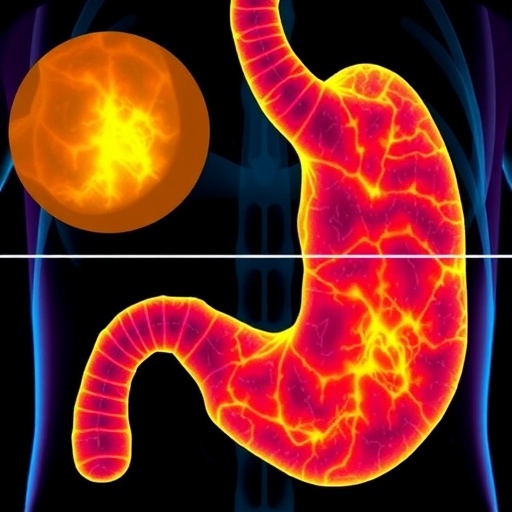
In the realm of pediatric care, managing patients who require sustained nutritional support often presents significant challenges. A recurrent procedure within this field is the replacement of gastrojejunostomy tubes, devices that play a crucial role in providing nutrition to children who are unable to eat through conventional means. A recent study conducted by Yatham et al. delves into the frequency and outcomes associated with gastrojejunostomy tube replacement in children within a single center, providing critical insights into the practicalities of this procedure. The findings underscore both the procedural considerations and the broader implications for child health management.
Gastrojejunostomy tubes have become a pivotal component of care in pediatric patients with varying medical conditions, including congenital anomalies, neurological disorders, and chronic gastrointestinal diseases. These tubes facilitate direct delivery of nutrients to the jejunum, bypassing the stomach, and are particularly valuable in patients who experience severe gastroesophageal reflux or delayed gastric emptying. Understanding how frequently these tubes need replacement and the outcomes associated with the replacements is vital for improving patient management and resource allocation in healthcare facilities.
During the investigation led by Yatham and colleagues, the focus was not merely on the frequency of tube replacements but also on the factors that contribute to replacement needs. In this study, the researchers meticulously collected and analyzed data from a cohort of pediatric patients outfitted with gastrojejunostomy tubes. The comprehensive nature of the analysis included a range of variables from the patient demographics to specific medical histories that influence tube longevity. Such data are imperative in establishing guidelines for optimal management of tube-dependent pediatric patients.
.adsslot_Qkh4tvHgJf{width:728px !important;height:90px !important;}
@media(max-width:1199px){ .adsslot_Qkh4tvHgJf{width:468px !important;height:60px !important;}
}
@media(max-width:767px){ .adsslot_Qkh4tvHgJf{width:320px !important;height:50px !important;}
}
ADVERTISEMENT
One of the more striking outcomes from the study was the identification of the most common reasons behind premature tube failures. Factors such as accidental dislodgement, clogging, and tissue irritation at the insertion site were prevalent and played critical roles in the decision to replace the tubes. By identifying these causes, healthcare professionals can address them more proactively, perhaps by implementing additional training for caregivers or refining techniques related to tube care and maintenance. This proactive approach might significantly reduce the rate of unexpected replacements, thereby enhancing patient comfort and family satisfaction.
Moreover, the study also provided a deeper understanding of the complications that can arise from tube replacements. Complications might range from mild inconveniences, such as site infections, to more severe issues such as perforation of the intestines, which can have dire consequences for the patient. By documenting these complications, the research serves as a crucial resource for clinicians in weighing the risks and benefits of tube management strategies. Enhanced awareness of potential complications leads to more informed decision-making regarding care protocols.
Another critical aspect revealed by the research pertains to the impact of socioeconomic factors on tube management practices. Children from various backgrounds face different challenges with healthcare access and adherence to recommended tube care. This disparity may influence replacement rates and overall patient outcomes, as well as highlight the need for tailored educational resources and support services aimed at families. An inclusive approach that addresses these socioeconomic differences is essential for improving care equity within pediatric health services.
Additionally, the study underscores the importance of multidisciplinary teams in the management of gastrojejunostomy tubes. Pediatric gastroenterologists, dietitians, nurses, and therapists must collaborate to create robust protocols for tube maintenance, recognizing that teamwork can significantly influence outcomes. This collaborative framework is not merely theoretical; the paper illustrates practical examples of how interprofessional collaboration has led to improved care in the authors’ clinical practice.
Equally important is the emotional and psychological toll that tube dependency imposes on families. Families of children with gastrojejunostomy tubes often endure immense stress as they navigate diet management and the associated responsibilities of tube care. By acknowledging this emotional aspect, healthcare providers can foster environments that offer not only clinical support but also emotional and psychological encouragement for both the patients and their families.
In examining the outcomes of tube replacements, the authors specifically looked at nutritional status and growth patterns of the children involved. Adequate nutritional intake is a cornerstone of pediatric health, and failures in tube function can lead to significant risks for malnutrition and stunted growth. The researchers correlated replacement intervals with nutritional assessments to highlight whether timely tube maintenance directly supports optimal growth trajectories in children.
This research contributes to a growing body of literature that calls for the refinement of clinical practices surrounding feeding tubes in pediatrics. It advocates for systematic protocols that ensure timely replacements, risk assessment frameworks for complications, and comprehensive family support networks. By prioritizing these aspects, healthcare systems can better serve vulnerable pediatric populations while fostering healthier outcomes.
Moreover, as technology and medical devices evolve, it is essential for ongoing studies to explore innovations in tube design and materials. Future advancements could aim to enhance the durability and functionality of gastrojejunostomy tubes, potentially reducing replacement frequencies and complications. Keeping pace with technological advancements will be vital for pediatric healthcare providers aiming to improve the quality of care.
As the findings of Yatham et al. provoke discussion within the medical community, it is evident that ongoing research and practice improvements are crucial. The landscape of pediatric health is ever-evolving, and practitioners must remain vigilant in their efforts to adapt to new insights and methodologies that can markedly benefit their patients. The commitment to increasing awareness and understanding through such studies will ultimately lead to enhanced quality of life for children reliant on gastrojejunostomy tubes.
In conclusion, the detailed study on gastrojejunostomy tube replacement not only provides valuable clinical insights but also reinforces the need for a holistic approach to pediatric patient care. By championing effective protocols, multidisciplinary collaboration, and family support, healthcare professionals can significantly improve outcomes for children who depend on these life-sustaining devices. The research serves as a clarion call for continuous reflection and advancement in pediatric nutritional support.
Subject of Research: Gastrojejunostomy tube replacement in children
Article Title: Frequency and outcomes of gastrojejunostomy tube replacement in children – a single-centre experience.
Article References:
Yatham, S. ., Herbert, L. & Rogers, A. Frequency and outcomes of gastrojejunostomy tube replacement in children – a single-centre experience.
Pediatr Radiol (2025). https://doi.org/10.1007/s00247-025-06310-6
Image Credits: AI Generated
DOI: https://doi.org/10.1007/s00247-025-06310-6
Keywords: Gastrojejunostomy, tube replacement, pediatric care, nutritional support, complications, multidisciplinary teams, socioeconomic factors, emotional support.
Tags: challenges in pediatric nutritional supportchronic gastrointestinal diseases in pediatricscongenital anomalies in childrendelayed gastric emptying in pediatric patientsdirect nutrient delivery in childrenfactors influencing tube replacement frequencygastroesophageal reflux managementimplications for child health managementimproving healthcare resource allocationneurological disorders and feeding tubesoutcomes of gastrojejunostomy tube procedurespediatric gastrojejunostomy tube replacement





